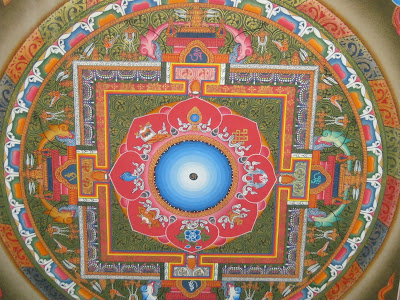Nepal vs. America: The Facts
A Fulbright friend posted a link on Facebook to a site that compares statistics in Nepal to statistics in America. The facts are shocking, but so is the comparison of size - I knew Nepal was small, but when you're on the bus for HOURS it seems bigger - it's not. The difference is the ease of transportation... infrastructure makes such a big difference.
http://www.ifitweremyhome.com/compare/US/NP
Thangkas
Last week, I bought my first real works of art when my friends took me to a thangka shop because they were appalled I had no idea what a thangka was. Thangkas are paintings by created for a spiritual purpose, usually found in Buddhism and Hinduism, and are painted by extremely talented artists in Nepal, where the style originated. Most thangkas are hung in a beautiful silk broadcade, though a few (particularly mandalas)are placed in frames. Typically the thangka paintings depict an image of the buddha or holy being, a mandala (the symbolic representation of the unfolding of the universe as seen by an enlightened mind), or illustrates principals of the dharma like the Wheel of Life. In the Tibetan Buddhist faith it is considered meritous to sponsor or commission a thangka because it's the creation of the image of the buddha or another deity, and the thankga must be treated with serious respect, as if they are actual buddhas or worlds.
When you purchase a thangka, rather than simply picking it out due to its aesthetic appeal, you choose your thangka based on the deity or concept you wish to become more familiar with (meditation is the process of becoming familiar), and also how the painting "speaks" to you. I chose the Om Mandala for two reasons. One, as I'm not a practicing Buddhist (rather, Christian), the Om Mandala is the least "Buddhist" - or Hindu - in a specific sense because rather than depicting a deity, it depicts the sacred sound of the universe. Also, when looking around at all the amazingly beautiful thangkas, none spoke to me like the mandalas did. Ultimately I ended up purchasing two - a yin and yang so to speak. The blue mandala brings me into myself and I meditate inwardly. The pink mandala pulls me back out again so that I can rejoin the world. For me, they were the perfect balance for what I was looking for and I was shocked to see movement as I looked at each mandala, but was assured by my friends and the proprietor that the movement is part of what happens when certain thangkas "speak" to you. All in all, I'm extremely pleased and can't wait to bring them back to America with me!


Christmas Presents! Santa's on Nepali Time...
I just received 2 packages from my family and a friend chock full of warm clothes and amazing food you can't find in Nepal. They were sent with plenty of time to make it by Christmas, but packages and luggage seem to have a difficult time finding me. A warning, I sound like a junk food addict, but you miss comfort food when you're away! My family's package had so many pairs of long underwear in it that I barely have any need for indoor heating anymore, as well as stuffing mix (which suddenly appeared at Bhat Bhateni a week ago, but costs an arm and leg), hot chocolate mix, and some favorite candy. My friend's package had lots of little trinkets and sour punch straws! Also, several Christmas cards appeared too. Thanks to everyone for your thoughtfulness - it made for a wonderful (and extended!) Christmas in Nepal!
Anti-Chex Mix
So the other day, I had a sudden craving for Chex Mix, caused by seeing the "ch. mix" on the custom form. Turns out it stood for hot chocolate mix, but somehow my brain went straight to chex mix. I made a quick run to Bhat Bhateni (literately - you don't drive places less than a mile away here), to pick up ingredients. The recipe called for chex, pretzels, peanuts, Worcestershire sauce, garlic salt, seasoning salt and butter. I was able to find peanuts, Worcestershire sauce and butter. Not to be deterred, my chex mix became a mix of cheerios, peanuts and cheese balls with garlic cloves chopped to give the garlic flavor, added salt, and some kind of traditional Nepali seasoning I found in the cupboard as well as the W. sauce and butter. If that was all the changes I had to make it would've been too easy. The mix was then cooked in a toaster oven, perfectly timed to outwit the 14 hours/day of loadshedding we have now! Verdict - delicious :) Who needs recipes in Nepal?
By the way - you read that right - 14 hours of loadshedding each day. The 10 hours of electricity are divided up between sleeping hours (most found in the middle of the night), and the middle of day when you're usually not home anyway. Fortunately we do have an inverter which gives us light and internet, though with the extended loadshedding schedule the inverter can't keep up and we're plunged into darkness several hours a day already. Can't wait for 20 hours/day....
More research posts to come, but they'll likely have fewer pictures unless the internet decides to speed up a little!
Random Nepali Language Fact of the Day:
Baahira - outside
Bahira - deaf
*No wonder I get odd stares when I tell people I'm deaf - there's a good chance they think i'm telling them I'm outside! Sign language may be accompanying that announcement in the future...
















